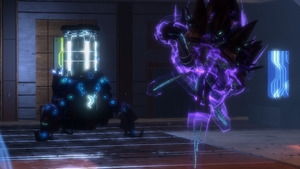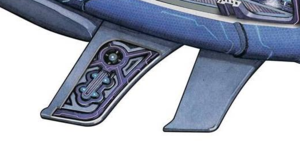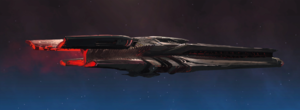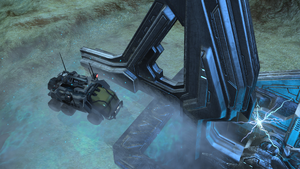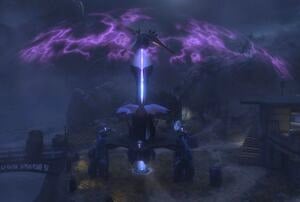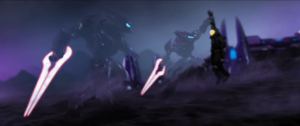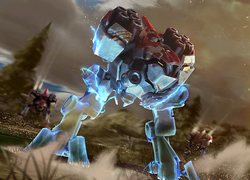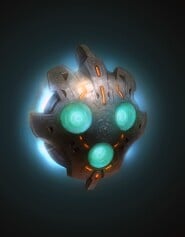Electronic warfare
From Halopedia, the Halo wiki
| There is more information available on this subject at Electronic warfare on the English Wikipedia. |
Electronic warfare (also known as EW or EWAR) is warfare involving the use of the electromagnetic spectrum or directed energy to attack an enemy, impede an enemy's use of the electromagnetic spectrum, or collect information.
Overview[edit]
Attack[edit]
Electronic attack (EA), or electronic countermeasures (ECM), is the offensive use of the electromagnetic spectrum or directed energy weapons to attack enemy personnel, facilities, or equipment with the intent to diminish or eliminate enemy combat capability. The most common form of electronic attack is "jamming." In its broadest sense, any laser, plasma, particle beam, and hard light weapon could be considered a form of electronic attack given that they utilize directed energy to attack targets. However, these are commonly considered standard munitions and generally do not have any of the functionality typically associated with electronic warfare technologies.
Protection[edit]
Electronic protection (EP), or electronic counter-countermeasures (ECCM), are measures taken to protect against electronic attack or to minimize the effectiveness of the use of the electromagnetic spectrum by the enemy. These measures include many forms of stealth technology intended to hide friendly personnel, vehicles, or facilities from view. Additionally, the means of hardening electronic devices against the effects of electromagnetic pulses falls under electronic protection. Electronic protection most often takes the form of active and passive stealth technologies.
Support[edit]
Electronic warfare support (ES) involves technology and measures taken to detect, intercept, or locate sources of electromagnetic energy for the purpose of tactical benefit. Electronic support most often takes the form of communication interception.
[edit]
Human usage[edit]
Some classes of United Nations Space Command warships possess electronic countermeasure systems. The Paris-class heavy frigate's countermeasures are capable of jamming an Ceudar-pattern heavy corvette's communications for several minutes, as evidenced by the UNSC Savannah disrupting the Ardent Prayer's communications during Operation: UPPER CUT.[1] Anlace-class light frigates have the option of being equipped with electronic warfare modules, allowing them to mask a UNSC presence or inhibit communication between enemy ships.[2] When employed in pairs, two Anlace-class frigates are capable of projecting a jamming blanket around an entire planet, preventing communications within this zone.[2][3]
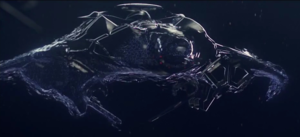
Given their widespread use in stealth infiltration/exfiltration, all classes of prowler notably feature electronic protection capabilities in the form of stealth technology, but many also include electronic attack and support technologies to directly assist in military actions and to gather intelligence.[4] Prowlers' hulls are often covered in a stealth ablative coating that make the vessel's profile virtually undetectable when targeted by radar, though requires extensive maintenance.[5] This coating is often paired with active camouflage technologies such as texture buffers to make the vessels invisible to visual detection as well.[6][7] The largest member of the prowler family—the Point Blank-class prowler—makes use of powerful jamming technology capable of blocking all outbound communications within a targeted area.[8] The Sahara-class heavy prowler incorporates a large dish on its dorsal surface that contains both passive and active sensor systems for narrow-band signal manipulation. Additionally, the vessel features parallel passive phased-scanners for long-ranged threat detection.[9][10] Perhaps most interestingly, the Sahara-class includes two XEV9-Matos nonlinear pulse cannons capable of disabling enemy warships via EMP, one of the most direct methods of electronic attack.[4][11] The Winter-class prowler is particularly well-suited to electronic warfare with a full suite of cloaking technologies designed to reduce and distort their emissions and sensor profile. If detected, the Winter-class's turrets even incorporate electronic warfare countermeasure dispensers that can launch projectiles such as heat sinks and deception jammers to confuse sensors or break target locks.[7] The Chiroptera-class subprowler incorporates advanced counter-intrusion software to protect against electronic attacks.[12]
Several classes of UNSC dropship incorporate electronic warfare technologies. These include the U81 Condor, a variant of the D81 Condor dropship that features an advanced electronic warfare suite and passive sensor array.[13] The D77 Pelican includes several forms of electronic warfare technologies including wide-spectrum flares, microdrone decoys, rainbow laser blinders, RADAR/LIDAR sensors, directional jammers, and "hard chop" guillotines on data processing modules to minimize their susceptibility to cyber intrusion.[14] Bogof, a Pelican dropship attached to the UNSC Port Stanley, was upgraded by the Huragok Requires Adjustment with reactive camouflage and an electronic warfare technologies.[15] While it does not feature the stealth ablative coating or active camouflage technologies commonly featured on prowlers, the D102 Owl utilizes a nanoblack biopolymer coating for stealth functions.[16]
The UNSC also makes use of naval munitions which incorporate electronic warfare capabilities. UNSC missiles can be fitted with specialized warheads that conduct jamming and decoy functions to disrupt enemy countermeasures, therefore having the capability to function in both electronic attack and protection roles.[17] Professor Ellen Anders led a project to upgrade the UNSC Spirit of Fire's Magnetic Accelerator Cannons that resulted in a specialized MAC round capable of emitting an EMP on impact, giving the weapon electronic attack potential.[18]
Covenant usage[edit]
Covenant vessels such as the an unidentified class of stealth vessel possess electronic countermeasures to counter the guidance locks on Archer missiles. One of these vessels used these countermeasures to disrupt missiles fired by the UNSC Iroquois during the Battle of Sigma Octanus IV. This class also features active camouflage technologies to render the ship virtually invisible,[19] a trait also shared by the Covenant intrusion corvette[20] and Akton-pattern escort.[21] In the case of the intrusion corvette, it has been recorded that their stealth systems require consistent maintenance. If optimal maintenance practices are not met, the effectiveness of the intrusion corvette's stealth systems decreases dramatically.[22] The Makar-pattern light corvette and Ceudar-pattern heavy corvette are both equipped with Ushab-pattern stealth generators, utilizing powerful distortion screens and a multispectral hypersink that renders the ships practically invisible to both human and Covenant long-range passive sensors. The Ceudar pattern also notably features a high-tier auspex array, utilizing the electromagnetic spectrum to examine slipstream space for approaching ships or probe vast distances in realspace to instantly map local planetary systems. These systems can also detect the subtle changes in planetary or ship atmospheres, which indicates the presence of Flood contamination.[23] Much larger ships, such as the Varric-pattern heavy cruiser Incorruptible, also possess electronic countermeasures for countering enemy plasma torpedoes, as well as counter-countermeasures.[24] Several classes of Covenant warships—such as the Hekar Taa-pattern blockade runner and Mutan Et-pattern storm cutter—feature hyperscanners.[25][26] Hyperscanners provide extremely-detailed information on any object in range, including internal scans and structural composition. The sheer volume of data available generally overwhelm biological Covenant crews, and as a result their workstations typically filter anything not of immediate tactical significance.[25] Several classes of warships—particularly cruisers—prominently feature external protrusions called sensor vanes, which either contain some or all of the ship's sensor equipment, or otherwise assist in their function.[27]
Hekar Taa-pattern blockade runners feature stealth systems unrelated to the more modern Covenant stealth shroud concept, instead relying on brute-force jamming and the use of small drones to conceal the ship's location.[28]
Banished usage[edit]
Due to the nature of their formation, the Banished utilize many of the same naval vessels and technologies as the Covenant before them, including carriers, cruisers, and corvettes. Notably, the Banished utilize modified Covenant intrusion corvettes and at least one Ceudar-pattern heavy corvette,[29][30] both vessels featuring stealth systems as a form of electronic protection.[20][23] The Banished also field several Jiralhanae-designed electronic warfare technologies. While its origins are found in the final days of the Covenant, the drekar is a stealth vessel utilized by the Banished that combines Covenant technology with Jiralhanae construction methods.[31] Reaching back into the history of the Jiralhanae, the Banished has revitalized development of voltaic weaponry such as electrolasers.[32] Primarily utilizing this technology for infantry weapons, the Banished dreadnought Ghost of Barolon was notably outfitted with an experimental electrolaser weapon.[26]
Forerunner usage[edit]

One of the most noteworthy uses of electronic warfare in naval combat is the Forerunners' attenuation pulse emitter, a multi-vector electronic warfare weapon that utilizes directed energy pulses and cyberwarfare payloads to neutralize and disrupt enemy systems.[33] The EMP-like blast generated by this weapon can spread across a planet rapidly, instantly disabling cities and spacecraft along with anything else reliant of electronics.[34] Notably, each Guardian Custode features two attenuation pulse emitters.[35] Some Forerunner warships have the ability to project confinement fields to block the movement of enemy vessels. These energy fields are even capable of being projected into the interiors of enemy vessels to incapacitate the crew.[36]
Forerunner vessels such as Acolyte-class harriers feature advanced stealth capabilities which can make them more difficult to detect than UNSC prowlers.[37] Another common form of electronic warfare technology fitted onto Forerunner starships is the ultrascanner, a long-range scanning system that can examine slipspace for approaching ships and probe vast distances in realspace to instantly map local planetary systems. Ultrascanners can also detect the subtle changes in planetary or ship atmospheres that are indicative of Flood contamination.[23] Sojourner-class dreadnoughts were fitted with ultrascanners during the Forerunner-Flood war, and Sentinel models like the Regulator and Constructor are also equipped with low-tier ultrascanners.[38] Halo installations are known to feature electronic countermeasures in the form of a jamming barrier that can block communications on and around the Halo in an effort to keep the location of the installation unknown.[39]
Electronic warfare in terrestrial combat[edit]
Human usage[edit]
In the realm of terrestrial combat, human militaries utilize a myriad of electronic warfare technologies. Some are stationary structures like the watchtower, an automated device sometime constructed alongside UNSC firebases that uses microdrone clouds and former-Covenant hyperscanner technology to reveal enemy forces hidden by active camouflage.[40] Other human electronic warfare devices are mounted on or deployed from vehicles, while still others are infantry-portable. The technology behind the XRP12 Gremlin has its origins during the Insurrection where the UNSC used it as a testbed for non-nuclear electromagnetic pulse technology, hoping to use it to remotely prevent the detonation of weapons of mass destruction.[41] Following the Covenant's attack on Harvest at the dawn of the Human-Covenant War, the Gremlin's X23 Non-Nuclear Electromagnetic Pulse Cannon was developed with the intent of using it to disrupt Covenant generators and relay stations, though it also proved to be effective at disabling armored vehicles.[42] A variant of the M400 Kodiak is equipped with active camouflage systems.[43] As of 2560, at least one variant of the M15 Razorback undergoing field trials with the UNSC features an electronic warfare suite.[44] The EV-44 Nightingale sports basic forms of electronic warfare capabilities with its multi-spectrum smokescreen launchers and disposable jammers capable of concealing ground forces within a targeted area.[45]
The UNSC utilizes several infantry-portable pieces of electronic warfare technology. One such device is known as a "spoofer," which can be placed on an otherwise inoperable piece of technology—such as a locked or damaged door—to override it using an electrical current.[46] Office of Naval Intelligence infiltration teams have also been known to utilize the Shroud Screen, a small device which projects a holographic sphere capable of disrupting electro-optical sensors and motion trackers.[47] Another example of portable electronic warfare technology is the armor restraint, a puck-shaped device that can be attached to the surface of MJOLNIR Powered Assault Armor to short-circuit the exoskeleton and render the wearer immobile.[48] The UNSC has also fielded an energy shielding technology for MJOLNIR armor known as armor lock, which temporarily immobilizes user while overcharging their armor shielding. Upon deactivation of armor lock, the technology emits an electromagnetic pulse.[49] Another MJOLNIR-compatible electronic warfare technology is the Type-27 Responsive Holographic Form Emulator, a piece of revere-engineered Covenant technology that allows the user to create a holographic copy of themselves and command it to move to a certain location to deceive enemy personnel and sensors.[50][51] The Semi-Powered Infiltration armor commonly worn by Spartan-IIIs during the Human-Covenant War incorporates photoreactive panels on its outmost surface that can hide the wearer from sight in a manner similar to—though less advanced than—the Covenant's active camouflage systems.[52] Another common electronic warfare technology commonly incorporated into UNSC armor is data management system called Visual Intelligence System, Reconnaissance, or VISR. Many variants of VISR exist,[50] with some being able to identify enemies even when they are cloaked by active camouflage.[53] The Threat Sensor is another piece of electronic warfare device with the intended use of revealing hidden enemies. When fired from its handheld launcher, the device emits sensor pulses that are even capable of identifying targets utilizing active camouflage, relaying this information back to friendly MJOLNIR wearers.[54][55]

As with in the realm of naval combat, the UNSC utilizes several munitions with electronic warfare capabilities in terrestrial combat. These include the XGBU-302 bomb, capable of emitting a localized electromagnetic pulse and commonly deployed using the Maastricht/Raleigh Ordnance Delivery-Application System aboard the B-65 Shortsword.[56] Sergeant John Forge notably modified his personal Warthog to fire "Anvil rounds," specialized munitions that explode with an electromagnetic pulse.[57] The M3063 deployable turret is an automated turret that includes an electromagnetic pulse weapon to supplement its heavy machine gun.[58] The UNSC fields several examples of munitions fired by handheld weapons capable of emitting electromagnetic pulses, including the XM20 EMP grenade of the M319 grenade launcher and M460 automatic grenade launcher,[59] as well as the EMP variant of the 9X-G Gyroc rocket fired by the Echidna MLRS-1 Hydra.[60] At least two variants of EMP hand grenade are in service with the UNSC: the scramble grenade[61] and the stun grenade.[62]
Squads of Orbital Drop Shock Troopers have been known to incorporate electronic warfare specialists as part of their team composition.[63] Militaries such as the Militia of Mesra maintained dedicated electronic warfare squads within their battalions.[64] As another form of dedicated electronic warfare personnel, human factions regularly make use of volitional and nonvolitional artificial intelligences, which by default function as electronic warfare technology due to their digital nature. Some AI, such as Cortana, are created with electronic warfare specifically in mind, possessing greater than average intrusion and code-breaking capabilities.[65][66]
Covenant usage[edit]
While engaged in terrestrial combat, the Covenant and its remnants have been observed utilizing several forms of electronic warfare technology. The communications jammer is one such technology, placed onto the battlefield to disrupt enemy COM frequencies, preventing long-ranged communications in the region.[67] During planetary invasions, the Covenant may use stealth pylons to hide their forces from long-range sensors.[68] Some Covenant atmospheric craft have been known to utilize active camouflage technology for stealth missions. These include the Ru'swum-pattern Phantom and the Klavbrig Workshop Shroud. While the former is only capable of cloaking itself,[69] the latter can generate a localized cloaking field to hide nearby troops, vehicles, and other ordnance.[70] The Bkowe'nei-pattern Vampire features a stasis cannon, which functions as an electromagnetic pulse weapon. When targeted by a Vampire's stasis canon, the drive systems of enemy aircraft often fail, resulting in a deadly free fall.[71]
In the Covenant military, a "point" is a small grouping of specialists not under the command of an obedientiary, tasked with electronic warfare, reconnaissance, or communications proxies.[72] Several ranks of soldiers and roles within the Covenant and its remnants are known to utilize personal active camouflage systems. These include Arbiters,[73] Special Operations Officers,[73] Special Operations Unggoy,[73] Stealth Sangheili,[74] Sangheili Zealots,[75] Silent Shadow,[53] and Jiralhanae Stalkers,[76] among others. One specific active camouflage device used by the Covenant was the Type-3 active camouflage.[77] The personal active camouflage technologies utilized by the Covenant greatly reduce the visibility of the wearer while active by bending light around them, rendering the wearer's silhouette transparent.[78] Another feature incorporated into some Covenant infantry armor is the Type-27 Responsive Holographic Form Emulator. Utilized most commonly by Skirmisher Champions and Commandos,[79][80] this technology user to create a holographic copy of themselves and then command it to move to a certain location to deceive enemy personnel and sensors.[50][51]
The Covenant has fielded a variety of handheld weapons and devices with electronic warfare uses. Perhaps the most prolific of these are the various models of plasma pistol, which generally feature an alternative firing mode that fires a single overcharged burst of plasma with EMP properties capable of disabling energy shielding and armored vehicles.[81] Some Anskum-pattern plasma grenades have be seen to emit an electromagnetic pulse when detonated as well.[82] During the final weeks of the Human-Covenant War, Jiralhanae forces loyal to the Prophet of Truth utilized several hand-deployed pieces of electronic warfare equipment including the power drain and radar jammer. The former emits a localized EMP when active, disabling nearby energy shields and vehicles while the latter is designed to trick enemy motion trackers by emitting false-positive radio waves.[83] In a manner similar to the UNSC's armor restraint, the Covenant has fielded a "shock device" capable of rendering MJOLNIR armor immobile via a powerful energy pulse.[84] The Covenant has also been known to weaponize stasis fields. During his tenure as Arbiter, Ripa 'Moramee was granted unrestricted access to experimental stasis weaponry such as stasis mines.[85] In addition to utilizing cloaking technology, these mines utilize energy fields that envelope enemy forces when triggered, stunning and immobilizing them.[86]
In contrast to humanity's regular use of artificial intelligences in cyberwarfare and intrusion roles, the Covenant considered AIs to be dangerous and vile heresies,[87] citing a particular AI's betrayal of the Forerunners.[88] However, due to their systems' vulnerabilities to incursion by human AIs, the Covenant unvaulted counter-intrusion constructs such as the "Seeker" in an attempt to combat this issue. Created in ages long past, these constructs are much less sophisticated than their human-made counterparts. On one occasion, the Covenant managed to capture a human AI and attempted to isolate and convert the machine. This only resulted in a hostile, enslaved mind that managed to escape, replicating itself across many Covenant facilities and vessels.[87]
Banished usage[edit]
With much of their hardware sourced from the defunct interstellar empire, the Banished share many of their terrestrial electronic warfare technologies with the Covenant. When establishing outposts on a battlefield, the Banished utilize multiple types of structures specializing in electronic warfare. These include sensor towers, structures that can detect nearby forces that would otherwise be hidden by active camouflage.[89][90] Also included in this list are the cloaking generators, devices reverse-engineered from Covenant stealth pylons and capable of concealing entire Banished outposts from view.[89][91] On one occasion, a cloaking generator was used to hide a drekar and four karves on the surface of one of Netherop's moons.[37] The Banished have been known to deploy disruption emitters in combat, devices similar in use to the UNSC's XGBU-302 bomb that emit an electromagnetic pulse to disable nearby electronics.[92]
Like the Covenant before it, the Banished utilize several vehicles that incorporate electronic warfare technologies. The Banished procured a number of Klavbrig Workshop Shrouds from the Covenant's stores, often utilizing the vehicles' cloaking abilities to conceal raiding parties.[70] Occasionally, the Banished has been known to upgrade existing vehicles with personal cloaking generators, such as with the "prowling" variants of the Eklon'Dal Workshop Marauder and Dovotaa Workshop Reaver.[93]
The Banished field infantry units with personal active camouflage on a scale similar to that of the Covenant, remaining a technology that is primarily utilized by Sangheili. Banished Special Operations Sangheili, Sangheili Warlords, Sangheili Ultras,[94] Honor Guard Sangheili,[95] and certain Unggoy are outfitted with personal active camouflage.[96] Several Silent Shadow Sangheili—such as Inslaan 'Gadogai and Jega 'Rdomnai—are known to have joined the Banished as well,[97][98] with at least the latter continuing to use active camouflage in combat.[99] Another form of infantry-portable electronic warfare technology utilized by the Banished is the Threat Seeker, a device which can reveal the position of enemies hidden from view—functionality similar to the UNSC's Threat Sensor.[100][101]

Voltaic weaponry makes up the majority of the Banished's infantry-portable electronic warfare weapons. These weapons have their origin in Jiralhanae conflicts prior to the species' induction into the Covenant and Atriox himself commissioned Sicatt Workshop's Alchemy Corps to harness these technologies.[32] The Sicatt Workshop shock rifle is a directed energy sniper rifle that fires a burst of electrolasers capable of disabling energy shielding and vehicles, as well as playing havoc with MJOLNIR armor systems.[102][103] The Sicatt Workshop Disruptor is an automatic pistol that fires bolts that attach themselves to targets and unload powerful surges of electrical current capable of incapacitating enemy infantry and disabling vehicles and equipment.[103] Finally, the Sicatt Workshop dynamo grenade is a voltaic grenade that unleashes waves of electricity into targets within its radius of effect, immobilizing infantry and disabling electronics such as energy shields and vehicles,[104] much like the power drain utilized by Covenant Jiralhanae.[83] Additionally, several variants of Banished plasma mines utilize cloaking technology to avoid detection by enemy forces.[105][106]
While the Banished is not known to have the capability to produce artificial intelligences, at least one volitional AI by the name of Iratus came into their possession. Created by the human technology firm Lux Voluspa using a Jiralhanae brain as part of research into the concept of non-human donors for volitional AI, the Banished managed to steal Iratus via a cyberwarfare attack.[107][108] Assigned to managed the Banished's shipbreaking operations on Camber,[109] Iratus was ultimately stolen again, this time by Spartans Hieu Dinh and Sigrid Eklund. Dinh was forced to insert Iratus into his neural interface and the Spartans took the AI to the Avery J. Johnson Academy of Military Science.[107] Iratus attempted to break Dinh by forcing him to relive painful memories of his past,[110] but the AI was ultimately removed from Dinh's interface and quarantined.[111] However, he would break containment and begin to infect the armor and neural interfaces of the academy's trainees.[112]
Forerunner usage[edit]
The Forerunners developed several advanced forms of electronic warfare technology for use in terrestrial combat. Perhaps most notably, the Forerunners commonly utilized bafflers and dazzlers to camouflage objects and areas that they wanted to remain hidden.[113] The former technology utilizes geometric distortions for camouflage,[113] while the latter technology causes visual and auditory delusions for those within range of the device.[113][114]

Several pieces of infantry-portable equipment and weaponry utilized by the Forerunners are known to incorporate electronic warfare functionality. The Z-5080 Promethean vision system allows the user to detect shapes and movement through solid barriers, even being capable identifying between friend and foe.[51][115] The Z-400 splinter grenade features the ability to create an ionized lattice cloud that can disable vehicles in a manner similar to that of an EMP.[116][117] The Forerunners also utilized constraint fields to restrain individuals.[118] Warrior-Servants such as the Ur-Didact could manipulate these energy fields in a manner akin to telekinesis.[119]
The Forerunner utilized artificial intelligences—called ancilla—on a scale far surpassing humanity. Ancilla were a standard component of Forerunner personal armor, interfacing directly with the wearer's mind. The ancilla stored and collated information recorded by the armor and the wearer's own sensory data, allowing both to be accessed later.[120] In addition to their own stores of knowledge, a personal ancilla could connect to a network—such as that of a starship—and provide information for the wearer at will.[121] However, the Forerunners' use of ancilla did not stop there. Across their ecumene, trillions of sapient ancilla maintained innumerable aspects of Forerunner society. With few exceptions, every Forerunner was accompanied by a personal ancilla throughout their life. These ancilla served as advisors, teachers, recorders, and mediators to all Forerunner Information systems and the Domain.[122] The most notable classes of ancilla are monitors: administrators, assistants, guards, and caretakers created to govern large facilities and oversee their processes,[123] and Metarch: hyper-advanced ancilla created to serve the Ecumene Council, with the purpose of managing large swaths of the ecumene's operations.[124] Some Metarchs have even been tasked with coordinating entire war efforts.[125]
The Forerunners also developed a technology for countering ancillas known as an AI suppressor. These devices were designed to deactivate ancillas, capable of debriefing and transferring all the targeted ancilla's data.[126] The suppressors could also be used to subsume the ancilla within a Forerunner's personal armor or to physically restrain an individual, preventing their armor from healing them,[127] or forcing the wearer into unconsciousness.[128]
Production notes[edit]
During the development of Halo Wars 2, UNSC and Banished units labeled "E-War" were planned for the game, but they were ultimately cut.[129] These were intended to work as electronic warfare specialists and/or an infiltrator-type unit.[130] The final in-game Phoenix Log for the UNSC Armory still references the "Operative" units as one of the kinds of research it can conduct.[131]
Sources[edit]
- ^ Halo: Reach, campaign level Long Night of Solace (level)
- ^ Jump up to: a b Halo Encyclopedia (2022 edition), page 121
- ^ Halo: Shadows of Reach, chapter 13
- ^ Jump up to: a b Halo Encyclopedia (2022 edition), page 129
- ^ Halo: Ghosts of Onyx, page 291
- ^ Halo: Ghosts of Onyx, chapter 32
- ^ Jump up to: a b Halo: Warfleet, page 46-47
- ^ Halo: Silent Storm, chapter 7
- ^ Halo 4: The Essential Visual Guide, page 190
- ^ Halo Mythos, page 140
- ^ Halo: Glasslands, chapter 9
- ^ Halo Encyclopedia (2011 edition), page 259
- ^ Halo Waypoint, Condor (Retrieved on Jun 30, 2021) [archive]
- ^ Halo: Warfleet, page 44-45
- ^ Halo: Mortal Dictata
- ^ Halo: Shadows of Reach, chapter 2
- ^ Halo Encyclopedia (2022 edition), page 115
- ^ Halo Wars 2, campaign level The Cartographer
- ^ Halo: The Fall of Reach, page 195-196
- ^ Jump up to: a b Halo: Silent Storm, chapter 12
- ^ Halo: Fleet Battles: ADP-class escort in-game unit
- ^ Halo: Oblivion, chapter 5
- ^ Jump up to: a b c Halo Encyclopedia (2022 edition), page 376
- ^ Halo: Ghosts of Onyx, page 193-194
- ^ Jump up to: a b Halo: Warfleet, page 18
- ^ Jump up to: a b Halo Waypoint - Halo Infinite, Reckoning Intel (Retrieved on Jan 1, 2024) [local archive] [external archive]
- ^ Halo Waypoint, Canon Fodder - Calm in the Storm: "No, although the sensor vane layout is often a way of helping to differentiate between different patterns. For example, if you look closely most of the battlecruisers you see in Halo 3 are actually different from than the Ket-pattern Truth and Reconciliation described in Halo: Warfleet (pp. 62-63), despite their similar fin arrangement." - Kenneth Peters (Retrieved on Aug 4, 2021) [local archive] [external archive]
- ^ Halo Waypoint, Halo Community Update - Hot Drops & Flag Caps (Retrieved on Mar 1, 2021) [archive]
- ^ Halo Encyclopedia (2022 edition), page 460
- ^ Halo: Tales from Slipspace: Hunting Party
- ^ Halo Encyclopedia (2022 edition), page 461
- ^ Jump up to: a b Halo Waypoint, Canon Fodder - Fly Me to the Blood-Moon (Retrieved on Nov 27, 2023) [local archive] [external archive]
- ^ Halo Encyclopedia (2022 edition), page 377
- ^ Halo 5: Guardians, campaign level Guardians
- ^ Halo: Warfleet, page 88-89
- ^ Halo: Cryptum, page 193
- ^ Jump up to: a b Halo: Outcasts, chapter 6
- ^ Halo Encyclopedia (2022 edition), page 327
- ^ Halo: Combat Evolved Anniversary, Terminal 5
- ^ Halo Wars 2, Phoenix Logs: Watchtower
- ^ Halo: The Essential Visual Guide, page 83
- ^ Halo Wars: Official Strategy Guide - Firebase Units, page 38
- ^ Halo Wars 2: Stealth Kodiak Blitz in-game unit
- ^ Halo Encyclopedia (2022 edition), page 135
- ^ Halo Waypoint, Canon Fodder - The Art of War(s) (Retrieved on Jun 18, 2021) [archive]
- ^ Halo: The Flood, page 173
- ^ Twitter, Halo (@Halo): "SHROUD SCREEN - Developed primarily for use by ONI infiltration teams, the Shroud Screen create a localized field that disrupts electro-optical sensors and motion trackers." (Retrieved on Jan 6, 2024) [archive]
- ^ Halo 5: Guardians, campaign level Glassed
- ^ Halo: Reach: Game manual - Ordnance
- ^ Jump up to: a b c Halo 4: The Essential Visual Guide, page 139
- ^ Jump up to: a b c Halo 4 Official Site - Gameplay
- ^ Halo: Ghosts of Onyx, page 99
- ^ Jump up to: a b Halo: Evolutions – Motion Comics: Headhunters motion comic
- ^ Halo Waypoint, Inside Infinite - July 2021 (Retrieved on Jul 23, 2021) [archive]
- ^ Halo Infinite, campaign level The Tower
- ^ Halo: The Essential Visual Guide, page 176
- ^ Halo Wars 2: Phoenix Logs -Forge's Warthog
- ^ Halo 4, Autoturret in-game unit
- ^ Halo Encyclopedia (2022 edition), page 178
- ^ Halo Waypoint, Hydra Launcher (Retrieved on Jan 1, 2024) [archive]
- ^ Halo: Last Light, page 172: Google Play edition
- ^ Halo: Spartan Strike: Gameplay
- ^ Halo Wars 2, Phoenix Logs: Warrant Officer Quinn
- ^ Halo: Oblivion, chapter 2
- ^ Halo: The Fall of Reach, chapter 25
- ^ Halo: The Fall of Reach, chapter 27
- ^ Halo: Reach, campaign level New Alexandria
- ^ Halo: Reach, campaign level Nightfall
- ^ Halo 3, campaign level The Covenant (level)
- ^ Jump up to: a b Halo Wars 2, Phoenix Logs: Shroud
- ^ Halo Encyclopedia (2022 edition), page 289
- ^ Halo Encyclopedia (2022 edition), page 239
- ^ Jump up to: a b c Halo 2, campaign level The Arbiter
- ^ Halo 2, campaign level Cairo Station
- ^ Halo: Reach, campaign level Tip of the Spear
- ^ Halo 3: ODST, ODST
- ^ Halo Waypoint - Universe, Active Camouflage
- ^ Halo 4: The Essential Visual Guide, page 136
- ^ Halo: Reach, Skirmisher Champion in-game unit
- ^ Halo: Reach, Skirmisher Commando in-game unit
- ^ Halo Encyclopedia (2022 edition), page 291
- ^ Halo: First Strike, page 89
- ^ Jump up to: a b Halo Encyclopedia (2009 edition), page 343
- ^ Halo: Escalation, issue 11
- ^ Halo Wars 2, Phoenix Logs: Ripa 'Moramee
- ^ Halo Wars 2, The Arbiter - Leader power: Stasis Mine "Activate to deploy mines that stun and immobilize enemy units."
- ^ Jump up to: a b Halo Encyclopedia (2022 edition), page 217
- ^ Halo: Contact Harvest, page 188
- ^ Jump up to: a b Halo Encyclopedia (2022 edition), page 443
- ^ Halo Wars 2, Phoenix Logs: Sensor Tower
- ^ Halo Wars 2, Phoenix Logs: Cloaking Generator
- ^ Halo Wars 2, campaign level What Could Go Wrong?
- ^ Halo Wars 2: Prowling Marauder and Prowling Reaver in-game units
- ^ Halo Infinite: Campaign gameplay
- ^ Halo Wars 2: Honor Guard in-game unit
- ^ Halo Wars 2: Unggoy Prowling in-game unit
- ^ Halo Encyclopedia (2022 edition), page 459
- ^ Halo Encyclopedia (2022 edition), page 454
- ^ Halo Infinite, campaign level House of Reckoning
- ^ Halo Waypoint, Canon Fodder - System Shocks (Retrieved on Jan 13, 2024) [archive]
- ^ Halo Waypoint, SANDBOX OVERVIEW | SEASON 4 (Retrieved on Jan 13, 2024) [archive]
- ^ Halo: Shadows of Reach, chapter 19
- ^ Jump up to: a b Halo Encyclopedia (2022 edition), page 477
- ^ Halo Encyclopedia (2022 edition), page 483
- ^ Halo Wars 2, Atriox - Leader power: Plasma Mines "Activate to drop a line of cloaked mines. Once armed, mines explode on contact. Does not damage air units."
- ^ Halo Wars 2, Shipmaster - Leader power: Scout Mine "Activate to drop a cloaked Scout Mine. Explodes on contact, also provides vision within a small area."
- ^ Jump up to: a b Halo Waypoint, Halo Infinite: Defunct page; available on linked archive only (Retrieved on May 6, 2022) [local archive] [external archive]
- ^ Halo Infinite Lux Voluspa
- ^ Twitter, Halo (@Halo): "Uniquely created using a Jiralhanae brain donor, Iratus oversaw Banished shipbreaking operations on Camber where Spartan Dinh would trap the AI in his neural interface while Spartan Eklund hijacked a Phantom to escape to the Avery J. Johnson Academy." (Retrieved on Jan 12, 2024) [archive]
- ^ Halo Infinite, Mindfall: Enemy Mind cinematic
- ^ Halo Infinite, Interference
- ^ Halo Waypoint, Halo Infinite - Infection Intel (Retrieved on Jun 29, 2023) [local archive] [external archive]
- ^ Jump up to: a b c Halo Waypoint, Cryptum Glossary (Retrieved on Mar 14, 2014) [local archive] [external archive]
- ^ Halo: Cryptum, page 41
- ^ Halo 4: The Essential Visual Guide, page 138
- ^ Halo Waypoint, Splinter Grenade (Retrieved on Apr 13, 2016) [archive]
- ^ Halo Encyclopedia (2022 edition), page 395
- ^ Halo: Cryptum, page 303-305
- ^ Halo 4, campaign level Forerunner (level)
- ^ Halo: Silentium, page 41
- ^ Halo: Cryptum, page 107
- ^ Halo Encyclopedia (2022 edition), page 325
- ^ Halo Encyclopedia (2022 edition), page 371
- ^ Halo Waypoint, The New Halo Encyclopedia is Out Today (Retrieved on Mar 11, 2023) [archive]
- ^ Halo: Primordium, page 190-192
- ^ Halo: Cryptum, page 194
- ^ Halo: Cryptum, page 204
- ^ Halo: Cryptum, page 208
- ^ Halo Waypoint, Burn Baby Burn (Retrieved on Jun 1, 2020) [archive]
- ^ Twitter, Jeff Easterling: "Q: Some kind of Electronic Warfare Operator/Infiltrator?
A: Yeah that was pretty much the original intention." (Retrieved on Jun 1, 2020) [archive] - ^ Halo Wars 2, Phoenix Logs: Armory

